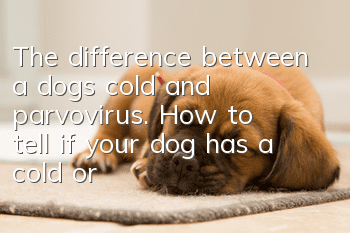The difference between a dog’s cold and parvovirus. How to tell if your dog has a cold or parvovirus?

Cold symptoms in dogs
Colds in dogs are mostly caused by colds due to weather changes and large temperature differences between day and night. Symptoms such as cough, watery nasal discharge, vomiting, diarrhea, sneezing and other symptoms are common, but they must be Distinguishable from influenza. Influenza is caused by a virus, has a sudden onset, is accompanied by fever, and has a high transmission rate. In addition to cold symptoms, it is also accompanied by conjunctivitis and gastrointestinal catarrh.
Cold treatment and care for dogs
For mild colds, dogs can be fed children's anti-cold medicines at children's dosages, such as children's cold granules and cold granules; but be careful not to feed dogs adult food of. Dogs with cough symptoms can take oral compound licorice tablets, 3-4 tablets/time, twice a day. Choose foods high in protein in your diet. Pay attention to keeping your dog warm at ordinary times. Even in summer, don’t be greedy for cold. Let them lie on the floor with the air conditioner blowing. Guide your dog to exercise more and drink more water.
Parvovirus symptoms in dogs
Enteritis type
Dogs with enteritis are initially depressed, anorexic, occasionally have fever, soft stools or mild vomiting, and then develop into frequent vomiting and severe diarrhea. At first, the feces will be gray, yellow or milky white with jelly-like mucus, and then there will be foul-smelling soy sauce or tomato juice-like bloody stools. The sick dog suffered rapid dehydration, weight loss, sunken eye sockets, messy coat, inelastic skin, cold ears, nose, and limbs, severe depression, shock, and death. The symptoms from mild to severe at the beginning of the disease generally do not exceed 2 days, and the entire course of the disease generally does not exceed a week.
Myocarditis type
It is more common in puppies between 4 and 6 weeks old. It often has no warning symptoms or only mild diarrhea, followed by sudden weakness, groaning, cyanosis of the mucous membrane, extremely difficult breathing, and rapid and rapid pulse. Weak, murmur appears on heart auscultation, and death often occurs suddenly (possibly due to acute respiratory depression) within a few hours.
The transmission rate of parvovirus is high and can be transmitted through feces, urine, vomitus, and saliva. Parvovirus infection will worsen within 2-3 days, and death may occur within a week without timely treatment. If you suspect that you are infected with parvovirus, you can use a parvovirus test strip to detect it. If it is positive, you must be sent to a doctor immediately for treatment.
Preventive measures for dogs
1. Do not take out dogs that have not been vaccinated;
2. When walking the dog, do not let the dog sniff everywhere, and be sure to keep it on a leash Rope, no eating;
3. Disinfect the kennel and living environment regularly;
4. Inject vaccines regularly
5. Do not feed milk, raw food and bones.
- Dog vomits white foam, be careful, it is a sign of disease
- Dogs vomit brown viscous liquid. Physiological and pathological reasons must be distinguished.
- Does a dog need to fast if it vomits? It depends on the situation
- Is it normal for a dog to vomit brown color? What should be done?
- Dogs vomit undigested food, pay attention to scientific diet
- What to do if your dog vomits yellow water How to deal with your dog vomiting yellow water
- How much does an Alaskan dog cost?
- What should I do if my dog vomits and won’t eat? Do the following things to solve it effectively.
- What kind of dog is greyhound?
- What food is good for dogs to eat when they are vomiting? Special care guide



